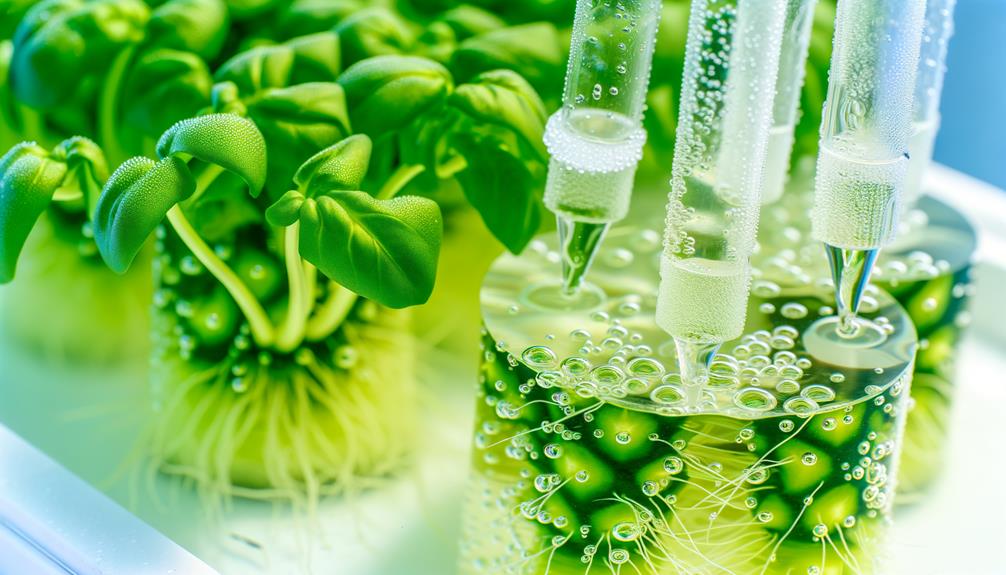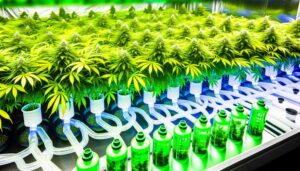Hydroponic Nutrient Solution for Vegetables
Hydroponic nutrient solutions are precisely formulated to deliver essential macronutrients (N, P, K) and micronutrients (Fe, Zn, Cu, Mn) critical for ideal vegetable growth. These solutions guarantee ionic balance, proper pH (5.5-6.5), and controlled electrical conductivity (1.5-2.5 mS/cm) to enhance nutrient uptake and plant health.
Regular monitoring and adjustments prevent deficiencies and toxicities. The balance between organic and synthetic nutrient options must be considered for targeted results.
Continuous refinement and real-time adjustments via automated systems can greatly boost crop performance and yield. Continue exploring to gain deeper insights into creating and maintaining effective nutrient solutions.

Key Takeaways
- Hydroponic nutrients include essential macronutrients like nitrogen, phosphorus, and potassium, crucial for plant growth.
- Micronutrients such as iron, zinc, and manganese are vital for enzyme functions and chlorophyll synthesis in hydroponic systems.
- Optimal pH range for nutrient absorption in hydroponics is 5.5 to 6.5.
- Regularly monitoring electrical conductivity (EC) and pH levels ensures balanced nutrient availability.
Understanding Hydroponic Nutrients

Hydroponic nutrients, consisting of a carefully balanced blend of essential minerals and trace elements, are critical for the ideal growth and development of vegetables in soilless cultivation systems.
These nutrient solutions are meticulously formulated to provide an excellent ionic balance, addressing the specific physiological requirements of various vegetable species.
Research indicates that nutrient availability and uptake are directly influenced by factors such as nutrient concentration, pH levels, and electrical conductivity (EC).
By fine-tuning these parameters, cultivators can maximize nutrient absorption efficiency, thereby enhancing plant health and yield.
Moreover, the precision in nutrient delivery reduces the risk of deficiencies or toxicities, ensuring a stable growing environment.
Understanding the complex interactions within hydroponic systems is essential for optimizing vegetable production.
Key Nutrients for Vegetables
Understanding the critical nutrients for vegetable growth in hydroponics involves recognizing both essential macronutrients such as nitrogen, phosphorus, and potassium, as well as crucial micronutrients like iron, manganese, and zinc.
Research indicates that a balanced nutrient solution is imperative for peak plant health and yield.
Analytical approaches to nutrient management guarantee that deficiencies and toxicities are minimized, promoting robust and consistent growth.
Essential Macronutrients for Growth
Ideal vegetable growth in hydroponic systems necessitates a precise balance of essential macronutrients, including nitrogen, phosphorus, and potassium.
Nitrogen (N) is critical for vegetative growth, influencing chlorophyll production and amino acid synthesis. Phosphorus (P) is paramount for energy transfer and genetic material development, playing a key role in root development and flowering. Potassium (K) regulates osmotic balance, enzyme activation, and photosynthesis.
Evidence suggests that optimal N-P-K ratios can considerably enhance yield and plant health. Analytical studies underscore that deviations in these macronutrient concentrations can lead to suboptimal growth and nutrient deficiencies.
As a result, maintaining these macronutrients within ideal ranges is fundamental for maximizing the efficacy of hydroponic vegetable production systems.
Importance of Micronutrients
Micronutrients, though required in smaller quantities than macronutrients, are indispensable for the physiological and biochemical functions essential to vegetable growth in hydroponic systems.
These trace elements guarantee peak enzyme function, chlorophyll synthesis, and nutrient absorption. Significantly, the absence or imbalance of micronutrients can severely impede plant health and yield.
Key micronutrients include:
- Iron (Fe): Crucial for chlorophyll synthesis and cellular respiration.
- Zinc (Zn): Critical for enzyme activation and protein synthesis.
- Copper (Cu): Necessary for photosynthetic electron transport and lignin formation.
- Manganese (Mn): Significant for nitrogen assimilation and photosynthesis.
Understanding the role of these micronutrients provides a foundation for developing nutrient solutions that maximize vegetable productivity and health in hydroponic systems.
Balancing Nutrient Levels
Balancing nutrient levels in hydroponic systems requires a meticulous approach to guarantee that both macronutrients and micronutrients are present in perfect concentrations to support robust vegetable growth and maximize yield.
Macronutrients such as nitrogen (N), phosphorus (P), and potassium (K) are pivotal for vegetative growth, root development, and fruiting. Simultaneously, micronutrients like iron (Fe), manganese (Mn), and zinc (Zn) are essential for enzymatic functions and chlorophyll synthesis.
The ideal nutrient solution must be continuously monitored and adjusted, utilizing tools such as electrical conductivity (EC) meters and pH sensors to maintain nutrient bioavailability.
Empirical studies underscore the significance of balancing these elements, as deficiencies or toxicities can lead to suboptimal growth and reduced crop productivity.
Creating a Nutrient Solution

To formulate an effective hydroponic nutrient solution for vegetables, it is essential to determine the precise concentration of macro and micronutrients required for ideal plant growth. This involves a thorough understanding of plant physiology and nutrient uptake mechanisms. Additionally, factors such as water pH, electrical conductivity, and temperature must be carefully monitored to ensure optimal nutrient availability. For instance, a well-balanced hydroponic nutrient solution for strawberries should provide adequate levels of nitrogen, potassium, and calcium to support fruit development and overall plant health. Regular testing and adjustments are necessary to maintain nutrient equilibrium and prevent deficiencies or toxicities.
Key factors to evaluate include:
- Macronutrients: Nitrogen, phosphorus, and potassium are needed in large amounts and are critical for growth and development.
- Micronutrients: Elements like iron, manganese, and zinc are required in trace amounts but are crucial for specific physiological functions.
- Solubility: Ensuring that nutrients are in a form that can be readily absorbed by plants.
- Compatibility: Avoiding chemical reactions that may precipitate nutrients, making them unavailable to plants.
These evaluations are fundamental in creating a nutrient solution that optimizes vegetable yield and health.
Balancing Ph Levels
Maintaining an ideal pH level is vital for maximizing nutrient availability and promoting healthy growth in hydroponic vegetable systems. A pH range of 5.5 to 6.5 is generally preferable for most vegetables. pH imbalances can lead to nutrient lockout, resulting in suboptimal plant health. Regular monitoring and adjustment using pH up or pH down solutions are essential.
| pH Range | Nutrient Availability | Impact on Plants |
|---|---|---|
| 4.0-5.0 | Limited | Poor growth, deficiencies |
| 5.5-6.5 | Preferable | Maximized growth, health |
| 6.5-7.0 | Reduced | Potential nutrient lockout |
| 7.0-8.0 | Minimal | Severe deficiencies |
Employing precise pH control mechanisms guarantees a balanced nutrient profile, fostering robust vegetable development and yield.
Common Nutrient Deficiencies

In hydroponic vegetable systems, nutrient deficiencies can severely impede plant growth and overall health, necessitating vigilant monitoring and precise nutrient management.
Common deficiencies include:
- Nitrogen Deficiency: Manifested by yellowing of older leaves due to insufficient chlorophyll.
- Phosphorus Deficiency: Causes stunted growth and purpling of leaves, often seen in cooler temperatures.
- Potassium Deficiency: Leads to browning of leaf edges and weak root systems, affecting overall plant vigor.
- Calcium Deficiency: Results in blossom end rot in fruits and tip burn in leafy greens.
These deficiencies require rapid identification and correction to prevent irreversible damage.
Employing regular nutrient solution analysis and adjustments guarantees ideal plant health and productivity.
Accurate diagnosis and timely intervention are vital for successful hydroponic cultivation.
Organic Vs. Synthetic Nutrients
Choosing between organic and synthetic nutrients in hydroponic systems demands a detailed understanding of their composition, benefits, and potential drawbacks.
Organic nutrients, derived from natural sources such as compost or manure, offer the advantage of promoting microbial activity and enhancing nutrient cycling. However, they can introduce inconsistencies in nutrient availability and risk pathogen contamination.
Synthetic nutrients, formulated from inorganic salts, provide precise nutrient ratios and are immediately available to plants, ensuring consistent growth and reduced disease risk. Yet, they may lack the beneficial microorganisms found in organic options and can lead to nutrient imbalances if not carefully monitored.
Selecting the appropriate nutrient type requires balancing these factors to optimize plant health and yield in hydroponic systems.
Nutrient Solution Maintenance

Effective nutrient solution maintenance is integral to optimizing hydroponic vegetable growth, necessitating regular pH monitoring to guarantee nutrient availability.
The frequency of solution replacement is critical to prevent nutrient depletion and accumulation of toxic byproducts.
Additionally, recognizing and addressing signs of nutrient imbalance can mitigate deficiencies or toxicities, thereby maintaining plant health and productivity.
Regular Ph Monitoring
Maintaining a stable pH within the ideal range of 5.5 to 6.5 is essential for guaranteeing nutrient availability and uptake in hydroponic vegetable systems. Regular pH monitoring is critical for optimizing plant health and growth.
Empirical studies reveal that fluctuations outside this range can lead to nutrient lockout, impeding absorption and potentially causing deficiencies.
Consider the following for effective pH management:
- Consistency: Regularly check pH levels at the same time each day to monitor stability.
- Accuracy: Utilize high-quality pH meters or test kits to guarantee precise readings.
- Adjustments: Employ pH-up or pH-down solutions cautiously to maintain the ideal range.
- Documentation: Keep thorough records of pH levels and adjustments for trend analysis.
Adhering to these practices enhances nutrient efficiency and maximizes crop yield.
Solution Replacement Frequency
The frequency at which the nutrient solution is replaced in hydroponic systems is a critical factor for ensuring ideal plant growth and nutrient balance. Empirical data suggest bi-weekly replacement as a standard, though this can vary based on plant species, growth stage, and system type.
Regular replacement mitigates nutrient depletion and accumulation of harmful salts. Research shows that maintaining nutrient concentrations within suitable ranges enhances root absorption efficiency and reduces phytotoxicity risks.
Analytical monitoring of electrical conductivity (EC) and total dissolved solids (TDS) provides quantitative metrics for determining replacement timing. By adhering to scientifically validated replacement schedules, growers can sustain suitable nutrient availability, thereby promoting robust and healthy vegetable growth.
Nutrient Imbalance Signs
Identifying nutrient imbalance signs in hydroponic systems is vital for maintaining ideal plant health and preventing growth abnormalities. Recognizing these imbalances early enables prompt corrective measures, ensuring optimal nutrient availability and uptake.
Common indicators of nutrient imbalances include:
- Chlorosis: Yellowing of leaves often signals nitrogen, iron, or magnesium deficiencies.
- Necrosis: Dead tissue spots may indicate a deficiency in potassium or calcium.
- Stunted Growth: Inadequate growth rates frequently point to insufficient levels of phosphorus or nitrogen.
- Leaf Curling: Abnormal leaf morphology, such as curling, can be symptomatic of micronutrient shortages, particularly boron or zinc.
Regular monitoring and precise adjustment of nutrient solutions are essential for sustaining a balanced hydroponic environment, thereby fostering robust vegetable growth and maximizing yield potential.
Optimizing for Growth
Consistently refining the nutrient composition and concentration is essential for maximizing vegetable growth in hydroponic systems.
Research indicates that precise ratios of macronutrients (N-P-K) and micronutrients (Fe, Mn, Zn, Cu, Mo, B) are critical for ideal plant health and productivity.
Analytical monitoring of Electrical Conductivity (EC) and pH levels guarantees nutrient availability and uptake efficiency. A study by Jones et al. (2020) demonstrated that maintaining an EC of 1.5-2.5 mS/cm and a pH of 5.5-6.5 greatly enhances growth rates and yield.
Additionally, adjusting nutrient solutions in response to plant developmental stages—vegetative versus flowering—can further refine growth outcomes.
Implementing automated dosing systems can facilitate real-time adjustments, guaranteeing continuous nutrient refinement and superior crop performance.
Conclusion
In the intricate dance of hydroponic vegetable cultivation, the nutrient solution serves as the lifeblood, ensuring robust growth and ideal yields.
By meticulously balancing essential elements and maintaining precise pH levels, cultivators can avert common deficiencies and enhance plant health.
The decision between organic and synthetic nutrients further underscores the complexity and precision required.
Ultimately, diligent maintenance and continuous enhancement of the nutrient solution create a fertile ground for thriving vegetable production.






